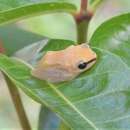Description
provided by AmphibiaWeb articles
A large Hyperolius (27–37 mm) from the central forest. Phase J: dorsum delicate greyish or yellowish green, with or without a fine pale yellow dorsolateral stripe; ventrum without heavy grey pigmentation, underside of limbs suffused with yellow or orange, gular flap sometimes tinged with green. A sample I collected in central R. D. Congo has ventrum bright green, except medially where it is yellow. Discs bright yellow. Throat of calling male conspicuously green-blue. Phase F: dorsum pale fawn to rich orange-brown, sometimes sprinkled with bright yellow spots. Ventrum and sometimes limbs more or less extensively pigmented with pale grey to deep black. Underside of limbs and sometimes gular flap suffused with bright pink. Throat of males orange. Pupil horizontal.In body proportions, habitat preference and voice H. phantasticus seems similar to the western H. guttulatus, but its coloration is quite different and the gular flap is smaller in H. phantasticus. It is remarkable that the Cameronese populations of H. guttulatus sometimes have black spots on the ventrum similar to, although less extensive than H. phantasticus. A further difference is that H. phantasticus lacks the white fold posterior to the gular flap which is found in Cameronese populations of H. guttulatus. The two species have been taken together.This species shows developmental changes in patterning, with two phases, J (juveniles and many mature males) and F (mature females and some mature males). All newly metamorphosed individuals are phase J, which is normally brownish to green with paired light dorsolateral lines, or an hourglass pattern. All females, and some males, develop into phase F before the first breeding season. Phase F is often colorful and variable, showing the diagnostic color characteristics for the species or subspecies. Either well-defined morphs may be present, or graded variation. H. chabanaudi is a synonym for H. phantasticus (Lötters et al. 2001).This account was taken from "Treefrogs of Africa" by Arne Schiøtz with kind permission from Edition Chimaira (http://www.chimaira.de/) publishers, Frankfurt am Main.
Distribution and Habitat
provided by AmphibiaWeb articles
Cameroun to R. D. Congo. Encountered in flooded coastal grassland, in central R. D. Congo in bushland localities.
Life History, Abundance, Activity, and Special Behaviors
provided by AmphibiaWeb articles
The males call at some height above the surface of shallow pools, often in open meadows. The voice is a sonorous “hoin”. The call has a rather long duration and well-developed rising bands of harmonics.
Hyperolius phantasticus: Brief Summary
provided by wikipedia EN
Hyperolius phantasticus is a species of frog in the family Hyperoliidae. It is found in Cameroon, Central African Republic, Republic of the Congo, Democratic Republic of the Congo, Gabon, possibly Angola, and possibly Equatorial Guinea. Its natural habitats are subtropical or tropical moist lowland forests, subtropical or tropical seasonally wet or flooded lowland grassland, freshwater marshes, intermittent freshwater marshes, rural gardens, heavily degraded former forest, and ponds.
- license
- cc-by-sa-3.0
- copyright
- Wikipedia authors and editors

